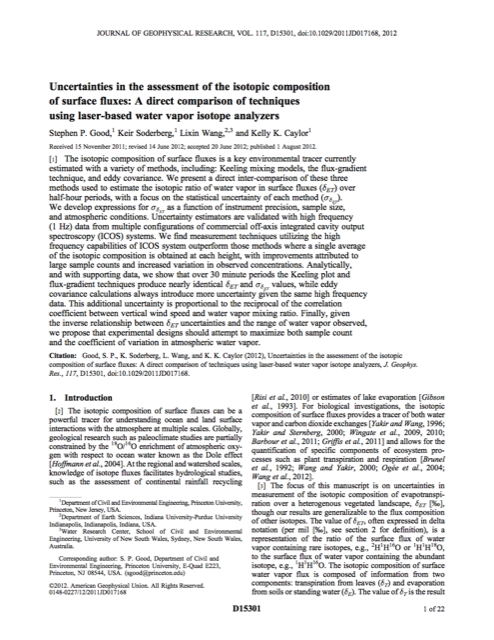Uncertainties in the assessment of the isotopic composition of surface fluxes: A direct comparison of techniques using laser-based water vapor isotope analyzers

∗Good, S.P., ∗Soderberg, K., ∗Wang, L., Caylor, K.K. (2012) “Uncertainties in the assessment of the isotopic composition of surface fluxes: A direct comparison of techniques using laser-based water vapor isotope analyzers”, Journal of Geophysical Research – Atmospheres, 117, D15301, doi:10.1029/2011JD017168
The isotopic composition of surface fluxes is a key environmental tracer currently estimated with a variety of methods, including: Keeling mixing models, the flux-gradient technique, and eddy covariance. We present a direct inter-comparison of these three methods used to estimate the isotopic ratio of water vapor in surface fluxes (δET) over half-hour periods, with a focus on the statistical uncertainty of each method We develop expressions for a function of instrument precision, sample size, and atmospheric conditions. Uncertainty estimators are validated with high frequency (1 Hz) data from multiple configurations of commercial off-axis integrated cavity output spectroscopy (ICOS) systems. We find measurement techniques utilizing the high frequency capabilities of ICOS system outperform those methods where a single average of the isotopic composition is obtained at each height, with improvements attributed to large sample counts and increased variation in observed concentrations. Analytically, and with supporting data, we show that over 30 minute periods the Keeling plot and flux-gradient techniques produce nearly identicalδET and values, while eddy covariance calculations always introduce more uncertainty given the same high frequency data. This additional uncertainty is proportional to the reciprocal of the correlation coefficient between vertical wind speed and water vapor mixing ratio. Finally, given the inverse relationship between δET uncertainties and the range of water vapor observed, we propose that experimental designs should attempt to maximize both sample count and the coefficient of variation in atmospheric water vapor.
